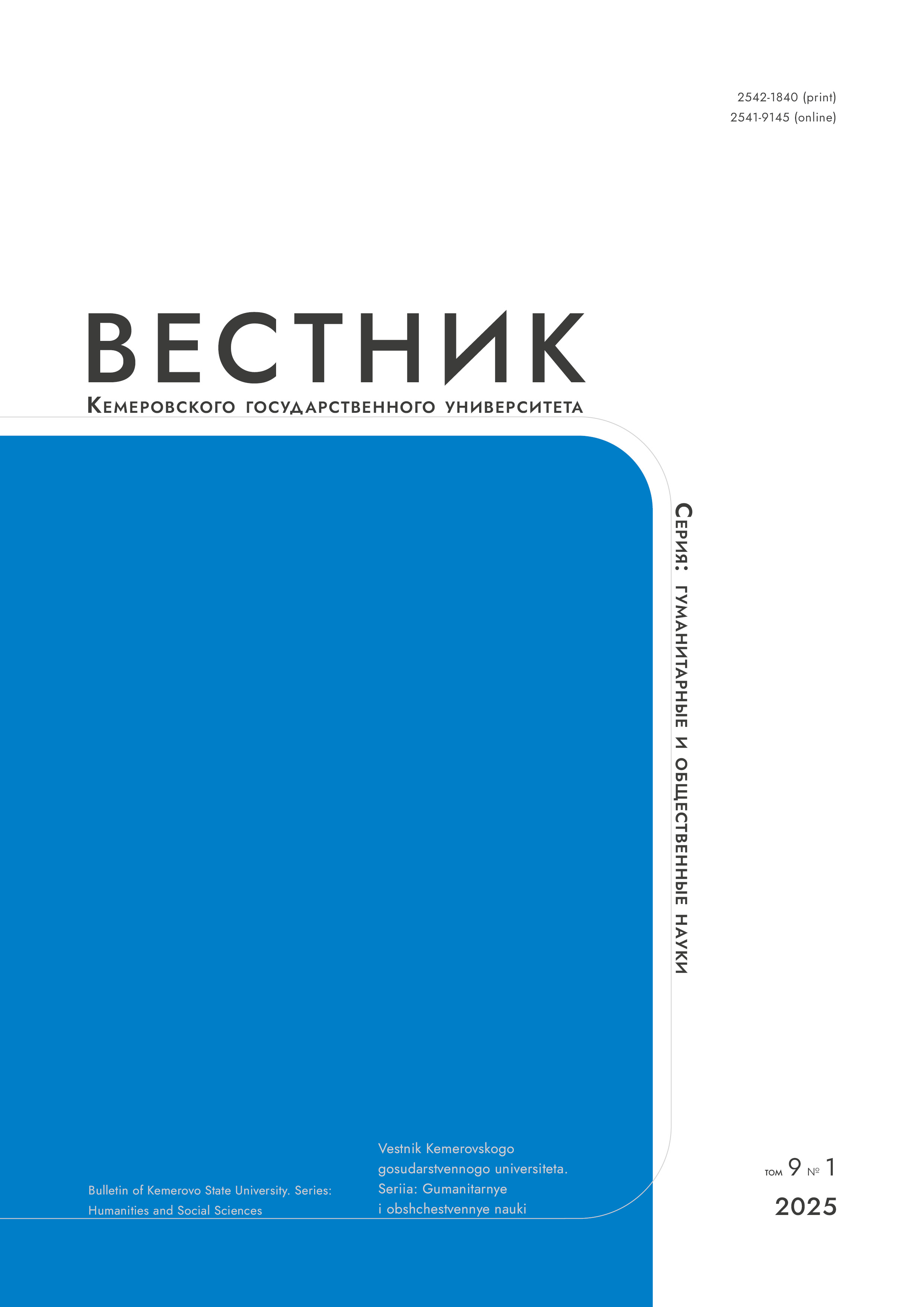from 01.01.2004 to 01.01.2023
Kemerovo, Kemerovo, Russian Federation
Kemerovo, Kemerovo, Russian Federation
Social informatization requires strong information security measures that would allow companies and individuals to protect their data. Courses in information security may solve this problem. However, methods of coding and encryption can be incorporated in the school curriculum as part of Mathematics and Computer Science. This article introduces an original reliable method of encoding to be integrated with the high school course of Mathematics. The authors used geometric methods of representing points in three-dimensional space bounded by a closed parallelepiped and elementary algebraic operations with matrices. The paper proposes flow and k-gram variants of the matrix method of text encoding and their program implementation in the Python programming language. The encoding methods require no special mathematical training, which makes them teachable to 9–11-graders. By mastering these methods, high-school students can increase their personal information security and develop an algorithmic style of thinking, as well as mathematical skills in general. The article contains some extramural tasks that consolidate practical skills of text coding. The academic and methodological materials make it possible to give the methods of coding and encryption while teaching Mathematics, as well as part of academic disciplines related to information security.
encoding, alphabet, text, parallelepiped, matrix, data protection, encryption, k-grams
1. Deza E. I., Kotova L.V., Lebedeva E. S. Theory and practice of teaching school and university students the basics of information security. Science and School, 2020, (1): 139-153. (In Russ.) https://elibrary.ru/jpznhs
2. Degtyareva A. A., Pchelintseva N. V., Makova N. E. Mathematical foundations of cryptology. Nauka i Obrazovanie, 2020, 3(2). (In Russ.) URL: http://opusmgau.ru/index.php/see/article/download/1789/1788/ (accessed 2 Jun 2023). https://elibrary.ru/jmndbw
3. Lepshokova A. R. Development of an interactive application for visual representation of Caesar's cipher. Relevant issues of methods of teaching computer science and mathematics in modern school: Proc. Intern. Sci.-Prac. Internet-Conf., Moscow, 24 Apr - 12 May 2020. Moscow: MPSU, 2020, 493-498. (In Russ.) https://elibrary.ru/cidefx
4. Koblits N. Course of number theory and cryptography. Moscow: TVP, 2001, 254. (In Russ.)
5. Munerman V. I., Samoilova T. A. Implementation of the Hill chipher algorithm on the algebra multidimensional matrices basis. Sistemy vysokoi dostupnosti, 2019, 15(1): 21-27. (In Russ.) https://elibrary.ru/yhtmfh
6. Svechnikov S. N. Frequency analysis when using classical crypto algorithms. Innovations in science and practice: Proc. II Intern. Sci.-Prac. Conf., Ufa, 17 Apr 2020. Ufa: Vestnik nauki, 2020, 57-62. (In Russ.) https://elibrary.ru/mdihus
7. Babash A. V., Guzovs R., Kasatkin S. V., Prokhorov A. N., Slimov N. A. Spreading borders of Vigenere cipher decryption methods. Voprosy kiberbezopasnosti, 2019, (5): 42-50. (In Russ.) https://doi.org/10.21681/2311-3456-2019-5-42-50
8. Zlatopolsky D. M. Some facts from the history of using the binary number system in the pre-computer era. Matematika v shkole, 2021, (5): 61-70. (In Russ.) https://elibrary.ru/aolmuw
9. Streltsova A. S., Ukhvarkin S. P., Filimonov V. V. Application of elliptic curves in the Diffie-Hellman algorithm. Science Almanac, 2019, (1-3): 62-64. (In Russ.) https://elibrary.ru/vwbmsa
10. Kuznetsov A. V., Shishkina E. L. Methods of algebraic geometry in cryptography. Voronezh: VSU, 2023, 125. (In Russ.) https://elibrary.ru/tlxomb
11. Gulevich S. A. General information about modern cryptography and approaches to its study. Ratio et Natura, 2022, (2). (In Russ.) URL: https://ratio-natura.ru/sites/default/files/2023-03/obschie-svedeniya-o-sovremennoy-kriptografii-i-podkhodakh-k-ee-izucheniyu.pdf (accessed 29 May 2023). https://elibrary.ru/pdvnht
12. Haikhan T. Yu., Nikulin V. V. Cryptographic protection of information. Vestnik obrazovatelnogo konsortsiuma Srednerusskii universitet. Informatsionnye tekhnologii, 2021, (1): 4-7. (In Russ.) https://elibrary.ru/rvsbpl
13. Kutovaya A. S. Matrix algorithms of cryptographic information protection. Fundamental and applied research in physics, mathematics and computer science: Proc. XVII (XLIX) Intern. Sci. Conf. of students, postgraduates and young scientists "Education, science, innovation: contribution of young researchers", Kemerovo, 21 Apr 2022. Kemerovo: KemSU, 2022, 171-174. (In Russ.) https://elibrary.ru/giygkv
14. Kuznetsova V. Yu. The ensuring competence of Russian students in cryptography issues: analysis of purposes, possible approaches, means of their software support. Caspian Journal: Control and High Technologies, 2019, (2): 163-170. (In Russ.) https://elibrary.ru/wximcq
15. Gredasova N. V., Koreshnikova M. A., Zhelonkina N. I., Korchemkina L. V., Polishchuk E. G., Ivanov V. M., Andreeva I. Iu. Linear algebra. Ekaterinburg: UrFU, 2019, 88. (In Russ.) https://elibrary.ru/wxmlrk
16. Bodrov E. N. Methodical development of a lesson on the discipline "elements of higher mathematics": matrix algebra. Prepodavanie matematiki v shkolakh Tverskogo regiona, 2020: 69-78. (In Russ.) https://elibrary.ru/rqufvm
17. Babenko A. S., Matytsina T. N. Scientific bases of the school course of mathematics. Algebra. Kostroma: KSU, 2022, 86. (In Russ.)
18. Kutovaya A. S. Elective course in Basic Cryptography for students of 8-9 grades with advanced study of mathematics. Fundamental and applied research in physics, chemistry, mathematics and computer science. Proc. XVIII (L) Intern. Sci. Conf. of students, postgraduates, and young scientists: Education, science, and innovation: contribution of young researchers, Kemerovo, 20 Apr 2023. Kemerovo: KemSU, 2023, 113-116. (In Russ.) https://elibrary.ru/dbepyw
19. Borovkov A. S. Profile training as a factor in the formation of schoolchildren's readiness to choose a profession. Pedagogy and psychology of modern education: theory and practice: Proc. 73 Sci.-Prac. Conf. "Readings of Ushinsky", Yaroslavl, 5-6 Mar 2019. Yaroslavl: YaSPU named after Ushinsky K. D., 2019, 186-189. (In Russ.) https://elibrary.ru/unnrwr
20. Grishkov D. Yu., Ausilova N. M. High-level programming language Python. Science & Reality, 2022, (1): 114-117. (In Russ.) https://elibrary.ru/okojbn
21. Bukharov T. A., Nafikova A. R. Migranova E. A. An overview of the Python programming language and its libraries. Colloquium-journal, 2019, (3-1): 23-25. (In Russ.) https://elibrary.ru/yxowbv
22. Pylov P. A., Protodiakonov A. V. Using and representing arrays in the NumPy library. Innovatsii. Nauka. Obrazovanie, 2020, (23): 258-266. (In Russ.) https://elibrary.ru/naiifo
23. Zvereva L.G., Kormanenko N. V., Kuznetsova U. S. Current trends in the development of teaching mathematics. The scientific heritage, 2019, (40): 16-18. (In Russ.) https://elibrary.ru/lwekma
24. Borboeva G. M. Role and place of images of geometric figures in the formation of spatial thinking students. Science, New technologies and Innovations in Kyrgyzstan, 2019, (11): 186-191. (In Russ.) https://elibrary.ru/txkpqi
25. Zémor G. Course of cryptography. Moscow-Izhevsk: R&C Dynamics, 2019, 256. (In Russ.)


















